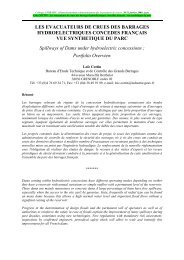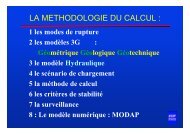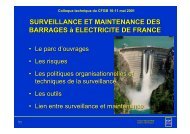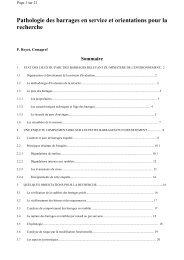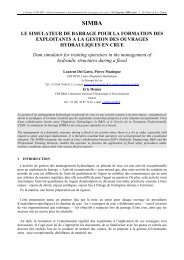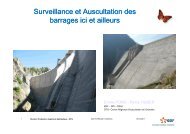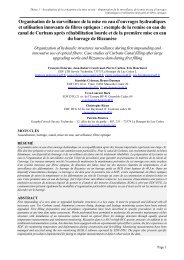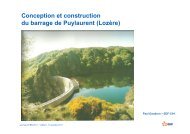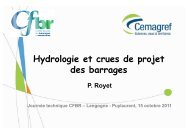SMALL DAMS
SMALL DAMS - Comité Français des Barrages et Réservoirs
SMALL DAMS - Comité Français des Barrages et Réservoirs
- No tags were found...
You also want an ePaper? Increase the reach of your titles
YUMPU automatically turns print PDFs into web optimized ePapers that Google loves.
Chapter III<br />
!" maximum pressure during LUGEON tests should be adapted to depth. In general<br />
pressure 1 is limited to about 0.3 to 0.5 MPa for the range of dams considered here. It<br />
should not be forgotten that this kind of test is only valid strictly speaking if the corresponding<br />
discharge/pressure curve is practically straight, which must be checked for every test<br />
by holding pressure at various stages (held for 10 minutes), following an ascending<br />
and then descending cycle (e.g.: 0.05 - 0.1 - 0.2 - 0.3 - 0.2 - 0.1 - 0.05 MPa);<br />
!"in case of "total water loss", continue testing to distinguish between filling of pockets<br />
and permanent flow;<br />
!" positioning the packer in ground that is strong enough to support the inflating pressure<br />
with no creep and homogenous enough to avoid any perforation of the membrane;<br />
!" checking head in the annular space between the injection rod and the temporary<br />
tube at the beginning and end of the test in order to detect and quantify any flow<br />
around the packer;<br />
!"preferably carrying out LUGEON tests as the work progresses with the same packer<br />
used each time, which halves the risk of water flowing around the packer;<br />
!" preferably measuring the pressure in the measurement chamber rather than at the<br />
drilling head (which always means inaccuracy in the calculation of head losses), and<br />
recording flow and pressure continuously in order to check that they remain constant<br />
during the test;<br />
!"for LEFRANC tests, the most difficult point is to know or to check the shape of the<br />
injection chamber and especially to isolate it correctly from the rest of the drillhole.<br />
One technique that is sometimes used is to install a packer for LUGEON tests, and<br />
inject water by natural flow by the central tube (constant or variable level). To get a<br />
meaningful response, a number of these tests must be done and each change of<br />
facies must be tested.<br />
It is possible to take undisturbed soil samples during core drilling. For fine soils, the<br />
recommended core drills are: stationary piston or thin wall sheathed ram, triple rotary<br />
drill with extension.<br />
Undisturbed soil samples must immediately be oriented and correctly numbered; sealed<br />
at both ends with paraffin wax (in order to avoid any loss of water); and handled,<br />
stored and shipped with care, or the representativity of the tests done will be<br />
questionable.<br />
The lengths of core corresponding to the samples taken can only be examined after<br />
the sheath has been opened in the lab. The drilling cross-section should therefore<br />
mention that a sample has been taken and the description of the ground will have to<br />
be completed later. A wooden block must always be used to replace the part taken<br />
out of the core box with an indication of the references of the sample.<br />
45<br />
1. Here we speak of effective pressure, i.e. the pressure at the centre of the test pass. If no system is<br />
available to measure pressure directly in the testing chamber, account must be taken of head losses and<br />
overpressure corresponding to the water column in the system (z = drop in altitude between the<br />
pressure gauge and natural groundwater level): Peff = Pmano - Pc + z/100 (in MPa).



